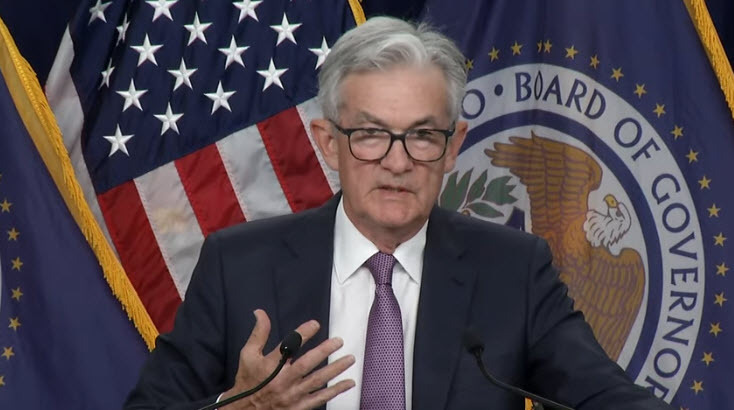
The Fed is expected to hike its target Fed Funds range by another 75bps to 3.75-4%, with a firm focus on the guidance and Powell's presser as the FOMC looks to step down the pace of tightening as it approaches the terminal rate, roughly in the 4.5-5% area. That comes despite a lack of progress in bringing inflation down, with concerns rising around the risk of overshooting on hikes. As a hawkish offset to expectations around an approaching Fed pause, Powell could use the meeting to signal a higher terminal rate - there are no new SEPs at this meeting - than the September 'Dot Plot' implied [4.6%], whilst continuing to lean on the "higher for longer" messaging. Although dovish risks include Powell signalling 50bps in December whilst failing to guide to a higher terminal rate; too much focus on financial stability also risks shifting expectations to a Fed pause.
Stubborn Data:
There is little ambiguity that the Fed will hike by another 75bps to 3.75-4% on Wednesday with the lack of significant progress on bringing inflation down to 2% or any rise in unemployment stressing the need to hike further into restrictive levels - money markets have 75bps priced at a near certainty. Core PCE is running at 5.1% Y/Y as of September, rising from 4.9% in August and back to the highest level since March, while the unemployment rate in September fell back to the post-COVID low of 3.5%. Somewhat encouragingly, the latest JOLTS job openings (as of August) fell over 1mln to 10.053mln, the lowest since July 2021, in a sign that labour market tightness, a key factor in this inflation episode, could be easing. The FOMC will be hoping for another decline in job openings when the September data is released on Tuesday.
Decelerating:
Despite the lack of meaningful improvement in the data, Powell is expected to signal an approaching deceleration in the pace of hikes from December as the Fed shifts focus to approaching the terminal rate. Any improvements in the data in Q4 will only embolden calls amongst the FOMC to decelerate its tightening pace to 50bps from 75bps in December over concerns of overtightening as rates approach officials' expected terminal rate (roughly in the 4.5-5% range); uncertainty around the US midterm elections could also work in favour of a softening in the Fed's tone. Indeed, Fed insider Timiraos at the WSJ confirmed that the November meeting could serve as a critical staging ground for future plans, including whether and how to step down to 50bps in December, while Fed's Daly also gave remarks on the eve of the blackout period calling on the need to step down the pace of tightening. A benefit of decelerating is that the Fed has the option to step hikes back up to 75bps if required, making it a hawkish risk rather than the norm. Furthermore, decelerating reduces the risks of overshooting into an inappropriately restrictive rate range given inflation is a lagging indicator. Albeit, the problem faced is the resulting reloosening of financial conditions, increasing the inflation risk premia, with concerns around a premature Fed pause.
Terminal Rate:
"One possible solution", writes Timiraos, "would be for Fed officials to approve a half-point increase in December, while using their new economic projections [in Dec.] to show they might lift rates somewhat higher in 2023 than they projected last month." The median dot in the September SEPs saw the terminal at 4.6% in 2023, with Fed officials largely pencilling in estimates around the 4.5-5% region - money markets have the terminal priced at 4.75-5% with cuts factored heading into 2023-end. As such it will be interesting to see if Powell uses the November FOMC, where there are no new SEPs, to forewarn of an expected higher terminal rate, particularly given the loosening of financial conditions seen in wake of the WSJ article and Daly comments on deceleration plans that saw a spike higher in inflation breakevens accompanied by the pick-up in stock appetite, fall in Treasury yields, and a weakening Dollar, not to mention the dovish developments at the ECB and BoC which have only added to central bank 'pivot' pricing. Fuel for a higher terminal estimate also comes from the resilience of consumer balance sheets, as Timiraos writes, "a more resilient private sector means that when it comes to rate rises, [terminal] may be higher than expected."
Balance Sheet:
A recent Bloomberg survey of economists showed a small majority still expect active MBS sales, although it's unclear when that would be announced. However, there are concerns regarding the Fed's balance sheet runoff given the increased fragility/illiquidity of the US Treasury market and elevated rates volatility, something which will likely act as a headwind for a decision on active asset sales due to the higher risk of a liquidity event. Interestingly, Fed's Daly made the effort to distinguish recently that interventions to stabilise a dislocated market are very different from QE, stressing that if there were dislocations in markets, the Fed could solve it even as it hikes rates and rolls off the balance sheet.
For more research like this check out Newsquawk's live squawk box. Get a 7-day free trial.